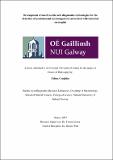Development of novel nucleic acid diagnostics technologies for the detection of predominant microorganisms associated with bacterial meningitis

View/
Date
2017-01-13Author
Coughlan, Helena
Metadata
Show full item recordUsage
This item's downloads: 1488 (view details)
Abstract
With an estimated 1.2 million cases annually worldwide, bacterial meningitis is a
medical emergency and primary prevention as well as accurate diagnosis and
treatment of this often fatal disease is paramount. The most common microorganisms
associated with bacterial meningitis are Haemophilus influenzae, Neisseria
meningitidis and Streptococcus pneumoniae.
Several vaccines are available for the prevention of bacterial meningitis caused by
these three microorganisms; however, these vaccines offer limited serotype coverage
and as a consequence bacterial meningitis cases as a result of non-vaccine serotypes
have emerged. Furthermore, limited vaccine availability in resource poor countries in
addition to vaccine failures is a major concern in the prevention of bacterial
meningitis worldwide. As such, patients with suspected meningitis require
immediate medical assessment and accurate diagnosis of the disease in order to
provide an optimal therapeutic regime. Moreover, as the incidence of bacterial
meningitis varies significantly by age and geographic location, the accurate
diagnosis of the causative microorganism would enable unambiguous
epidemiological studies to be carried out.
Presently, culture remains the gold standard for the diagnosis of bacterial meningitis,
however, this is limited in its ability to rapidly and accurately diagnose and nucleic
acid based diagnostic methods are more sensitive and specific for the diagnosis of
this fatal disease. The overall aim of this study was to design, develop, optimise and
validate robust, internally controlled nucleic acid based in-vitro amplification
methods for the rapid and accurate identification of H. influenzae, N. meningitidis
and S. pneumoniae. This was achieved using sequential experimental design
consisting of three main studies.
In the first study, RNA transcripts encoded for by the ssrA (tmRNA) and lepA (lepA
mRNA) genes were evaluated using real-time Nucleic Acid Sequence Based
Amplification (NASBA) as potential diagnostic targets for species specific
identification of H. influenzae, N. meningitidis and S. pneumoniae. This established
that tmRNA and lepA mRNA have potential as diagnostic targets for the species
specific identification of N. meningitidis and S. pneumoniae respectively. However,
neither the tmRNA transcript nor the lepA mRNA transcript can be used as a
diagnostic target to unequivocally differentiate H. influenzae from its most closely
related species Haemophilus haemolyticus.
In the second study, whole genome comparative analysis of H. influenzae and H.
haemolyticus identified two novel gene targets, phoB and pstA, present in H.
influenzae and absent in all other closely related species including H. haemoylticus.
Subsequently, two internally controlled real-time PCR diagnostic assays were
developed targeting both phoB and pstA and validated against an extensive panel of
H. influenzae isolates and non-H. influenzae closely related species for the specific
identification of H. influenzae. Analytical sensitivities of the real-time PCR
diagnostic assays developed were determined to be comparable to other published
diagnostic targets and more superior in terms of specificity than a previously
published diagnostics targets for the identification of H. influenzae.
In the third study, phoB was further validated as a diagnostic target for the species
specific detection of H. influenzae by targeting the phoB mRNA transcript in a
duplex real-time NASBA diagnostic assay. In addition, two duplex real-time
NASBA diagnostic assays were also developed targeting the RNA transcripts
encoded for by the ssrA gene and lepA gene for the species specific identification of
N. meningitidis and S. pneumoniae, respectively. All three duplex real-time NASBA
diagnostic assays were determined to be 100% specific for the target species tested
for and analytical sensitivities of less than 60 cell equivalents were determined for
each of the diagnostic assays in duplex format. Each real-time NASBA diagnostic
assay developed in this study includes an endogenous non-competitive Internal
Amplification Control (IAC) to amplify transcript 1 of the Homo Sapiens TBP gene
from human total RNA. By incorporating an endogenous internal amplification
control stably expressed at low levels in human blood, these duplex real-time
NASBA diagnostic assays have the potential to be used in a clinical setting for the
specific, sensitive and rapid (< 60 mins) detection and identification of the most
prominent microorganisms associated with bacterial meningitis in humans.
In summary, nucleic acid based in-vitro amplification diagnostic assays described in
this study are the first description of internally controlled real-time PCR diagnostic
assays and real-time NASBA diagnostic assay for the accurate, species specific
identification of H. influenzae, N. meningitidis and S. pneumoniae.

